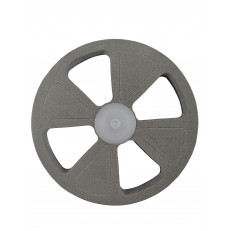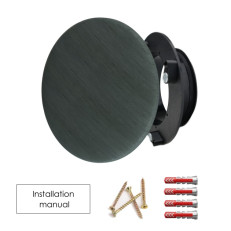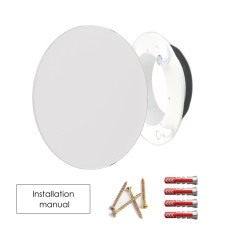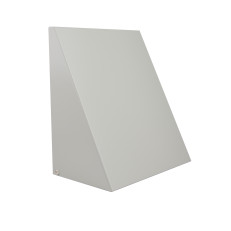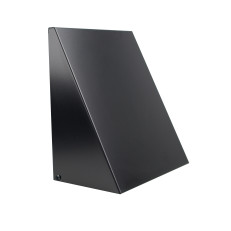Use of heat from the fireplace using a recovery unit
Quite a few of you are asking, or wants to solve the problem of how best to dissipate excess heat from the fireplace in a family home. The fireplace is usually located in the living room, where there is a risk of overheating, especially in passive houses. For distribution, there is no need to buy noisy fans and uncleanable pipes that some suppliers recommend. A recuperation unit can also be used for this purpose.
Basic conditions for a successful installation:
- space for SPIRO pipes with a larger diameter (125, 160, 200mm) + ensuring non-flammability of the surroundings
- the distance between the unit and the fireplace is not too large
- the ventilation recuperation unit supports zone regulation or indoor air circulation, but it is also possible to control the servo drive by other controls
- space for a mixing valve and a possible service opening for cleaning
Recommended solution A – conventional passive ventilation recovery unit:
A mixing valve (e.g. MSKM MIX ) with a servo drive is installed on the discharge branch (from the house to the unit) behind the silencer. The main route leads to the bathrooms, WC, kitchen, dressing rooms, etc. The second route leads to the fireplace. We will keep it closed most of the time and open it only when necessary - to use the fireplace.
On the unit, in weekly mode or manually, we set the start of extraction from the fireplace (zone activation). Such regulation is offered, for example, by Atrea Duplex units with RD5 regulation (new aM). It is therefore a solution where the heated air is blown into the recuperator and it largely transfers the heat to the supply fresh air, which is distributed throughout the house. Since the recuperator does not return 100% of the heat, part of the heat is blown away from the house. Despite the cost of this heat loss, it is sometimes the only possible way to distribute the excess heat from the fireplace, without major interventions in the ceilings, etc.
The examples of our projects below show a possible solution to the situation.
Example solution #1:
Example solution #2:
Recommended solution B – ventilation recovery unit with circulation:
This is a more efficient solution. The warm air from the fireplace is led up to the unit, which has multiple nozzles. The unit has the option to choose whether the air circulates around the house and efficiently distributes heat or whether it is in normal recovery mode. These units can often be retrofitted with a heat pump for cooling and reheating.
This is made possible, for example, by recuperation units of the DUPLEX RA5 type with five ports. Circulation is enabled, for example, by the Jablotron Futura .


source: www.atrea.cz
Recommended solution C - circulation for DUPLEX EC5/ECV5 units
In this case, the possibility of circulation in DUPLEX EC5 / ECV5 units is described using a mixing valve (e.g. TKR LM24 ) fitted with a servo drive for fresh air intake from the exterior. A side route from the mixing flap leads to the fireplace (ideally in galvanized SPIRO piping ) and is terminated with a heat-resistant end element (e.g. GAC 300x100 grid ).
The mixing valve is controlled by an external switch. When the switch is closed, the exhaust from the interior and the exhaust to the exterior are closed. The unit therefore does not ventilate but circulates and distributes excess heat from the fireplace throughout the house.
The possibility of using a heat exchanger
What to watch out for:
- at high temperatures - air cannot be sucked in from the fireplace insert - temperature too high. It is necessary to pay attention to the temperature resistance of all elements of the system, including the unit. We recommend really mixing not switching branches ON/OFF. The temperature at the ceiling above a conventional fireplace often reaches significantly above 100°C.
- always bring your own combustion air outside the recovery system to the fireplace. Usually galvanized square pipe. This too can be regulated, for example, by a valve with a servo drive.
- when most of the air volume is removed from the living room, a greater negative pressure is created, which may not be equalized as easily as during normal operation. We recommend keeping open doors to other overpressured rooms/corridors so that the negative pressure is reduced and that no fumes escape into the living room when putting it on fire. Alternatively, the function (A zone and or B circulation) can be deactivated for a while to place it in the fireplace.
- cleaning of the system - the suction grill near the fireplace and the pipe distribution must be cleaned
- don't forget the cabling between the unit and the servo drive. Select the servo drive according to the control type (unit, etc.)
What can be added for more comfort when using the fireplace:
- overpressure button – the unit supplies more air than it removes. It manifests itself in a better draft of the chimney during ignition. Can be set with a time delay similar to boost.
- filter box with higher heat resistance, which saves you money when replacing filters in the unit
- depending on the type of unit, room temperature sensor switching can be solved
Components used in the examples shown:
SONO pipes - SPIRO can also be used for better cleanability
Published on: 5/18/2020
Authors of the article: Ing. Pavla Skalická, Ing. Tomáš Trávníček - Luftuj sro





